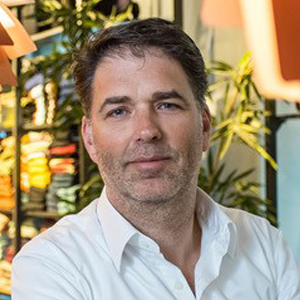
Companies have sustainability targets. Innovation in materials, and processes plus the entire ecosystem will need to learn and change. How does change take place? I spoke to Feico van der Veen of The Movement B.V. to understand his transformation journey.
I noticed a few years back that it had become a strategic imperative for big retailers and brands to invest in sustainability. I wasn’t really surprised, because the textile industry is one of the most polluting industries in the world. During the production process, it uses highly polluting methods and once products reach the customer, most of them are not worn and are non-biodegradable, contributing to massive amounts of waste. The biggest issue though, is that it’s an industry that is not really essential! The enormous volume of products generated in fashion isn’t really a need; it’s not crucial to our existence. Take the case of another highly polluting industry, the petrochemical industry. Is it needed? Yeah, it is required, because the old economy is still running on oil and petrol. So, if you change that too suddenly, then then the whole world will collapse.
In my meetings and travels with some of the top brands, I have discovered many things.
The first being that, while companies understand the need to be sustainable, achieving this is not very easy. It’s pretty complicated. People say they are sustainability-focused because they are selling organic cotton products. But, is organic cotton sustainable? It still needs huge amounts of water, and it requires much land. Sustainability is a jungle. How to prove that ‘eco-materials’ are sustainable? How to implement sustainability into the very conservative and foggy supply chain? How to prove that real, sustainable materials have been used in the end-product?
The second thing I have found is that every company now has strategic departments focused on sustainability. They are mostly connected to the top management and they decide on the sustainability direction of the company. On the other hand, their strategic direction is never really followed through by other departments such as the buying department. The buyers mostly have different goals, “I need to have a product for a good price, I need to make a margin, fast delivery, good quality, availability”. They don’t really care yet if the product is organic, recycled or any other innovative sustainable material. Buyers are rewarded by companies based on the performance of the products in the stores and their ability to buy them at the lowest price, i.e. maximizing profitability for the brand.
So, understanding sustainability is really about examining the gap between corporate strategy and operational issues.
Take the case of my journey with Polylana® yarn, a low-impact alternative for acrylic. This began with my discovery that while most materials were evolving to become organic or recyclable, with recycled polyester, one could not make the same effect as acrylic. Like the loft and hand-feel. This was an important finding because of the demand for acrylic in fashion accessories is vast. It is mostly needed for knitted outerwear like scarves, hats but also garments like sweaters.
My organization The Movement then, worked to develop an innovative substitute for acrylic. We developed an innovative polyester in China which has the same characteristics as acrylic, same loft, same hand feel and most interestingly you can dye it at low temperatures, unlike conventional polyester that you need to die on high temperature. This is also a big win, as dyeing at reduced temperatures lowers energy use significantly. Further, we were able to mix it with a maximum 50% recycled polyester to increase the impact reduction. Polylana® yarn is now patented and the trademark is registered worldwide. It’s being used by the big brands and retailers worldwide and the only branded low impact alternative for acrylic.
My definition of sustainability has to do with impact, nothing more, nothing less! Creating a 100% circular system will take another 10 to 20 years. But, you can do a lot right away, if you can choose a better material as an alternative for conventional materials. So, if instead of making something 100% acrylic, I can replace it by Polylana® which has a lower impact in terms of water and energy. Water is most important because at the moment we are in fact ‘stealing’ water from mostly poor production countries. For instance, one kilo of cotton needs 9,800 litres of water, water you cannot use for drinking water or irrigation of food crops, and the cotton is then mostly sent to Western countries. With our brand Aware™ we developed the first recycled cotton with a tracer. Our recycled cotton requires 0 liters of water!
What are the challenges in convincing buyers and how does it change product design?
Whatever sustainable innovation you want to present to brands, you have to first go through the sustainability manager because they set the standards and know exactly how to distinguish between greenwashing and genuine products.
However, when you go to the buyer, it’s about price and products quality. You, therefore, need to play a consultative role and not that of a person selling something. Some companies like Inditex have given standards to buyers. Inditex has the Join Life program for sustainability, and this is a centralized program. As per this Inditex has given KPI’s to buyers saying that “in 2020 you need to buy at least X% of everything which is Join Life compliant”. That makes their decision making so much easier. The buyer then immediately thinks, “fantastic, I can meet my internal KPIs and also do good”. However, let’s not forget that other things like price, quality and timely delivery are all important as well for the buyer.
Centralized decision making is beneficial because, if not for this, one has to go through buyers in every country of large brands and this is both time consuming and laborious. Inditex is an exception. In most other brands, decision making is decentralized and, in many instances, KPI’s of buyers are not aligned with sustainability standards.
At the next level are the designers. At Inditex one can talk to them and convince them to design for different materials which have a lower impact. So, it all begins with the sustainability manager, then the buyer. One then follows it up with the designer with the final consumer in mind.
Is it better design, or more designs faster?
Existing economic models in fashion are based on a large number of designs, sometimes more than 20 fashion seasons and a vast array of stores as distribution points. Whether it is the design of business or the design of clothes, the existing system needs to change, and change it will. But the change can’t come only from inside because people are invested in this conventional system and the jobs that go with it. But also all suppliers who produce the products.
The new generation will, however, bring in some fresh thinking, as they are very aware of what they buy and very conscious too about their impact. The Greta Thunberg generation of millions of kids will make a difference. They demand transparency. They want proof and trust that a brand is supplying sustainable products. They are the future consumers. Then retail will have to listen because they will not buy from them otherwise, and that will drive the change.
How does change happen downstream in the ecosystem?
If we all move to natural materials such as cotton, the demand will rise and so will the demand for land. However, there is so much pressure on land with rising populations, I believe we cannot grow more cotton than we do today. There’s no land and enough water anymore.
Also, many companies are investing in fantastic new sustainable technologies and materials, but they are in the early stages. For instance, leather from pineapple skin or oranges is fantastic but it’s impossible to scale up immediately. In the meantime, what can we do? We can do it differently.
Further, many organic and sustainable products are part of a very opaque system where its difficult to trace their origin.
To build trust, you need to build traceability. We can help the consumer by saying that, “I guarantee that this product you’re wearing, is really made from recycled content”. We developed a disruptive validation and verification system, where we add a tracer to genuine recycled materials. We can validate recycled materials in the end product with an USB-scanner and verify the related certification by blockchain technology. These decentralized blockchain-based technology systems are now emerging; they build trust and are also tamper-free. Customers need to be able to trust the system so that they can buy better.
So where should the company start the transition?
They should start by giving a massive push to the supply chain. 2020 is a symbolic year and I believe that 2020 will be a push to make a change. I feel it. I feel it everywhere I go.
Let’s make a change. Let’s do it. Let’s not let’s not keep on talking. But let’s first now, at this moment, start by using better materials which have a lower impact and that are sustainable. Don’t make it complicated.
In conversation with Feico Van Der Veen Managing Director, The Movement B.V.

